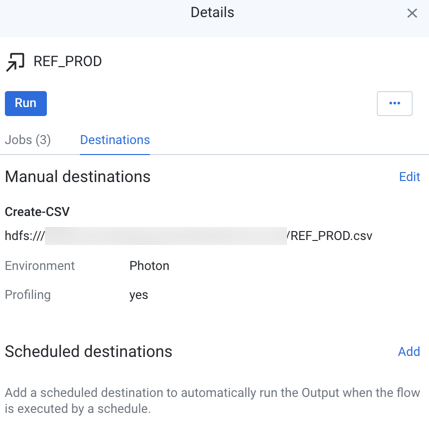View for Outputs
Associated with each recipe is one or more outputs. These publishing destinations can be configured through the context panel in Flow View. Through outputs, you can execute and track jobs for the related recipe.
 |
Figure: Output icon
Details options
The following options are available in the details context menu when you select an output.
Delete Output: Remove this output from the flow. This operation cannot be undone.
Removing an output does not remove the jobs associated with the output. You can continue working with those executed jobs. See Jobs Page.
Edit: Click this link to modify the selected destination's properties.
Tip
You can also right-click the output to view all the menu options.
Jobs tab

Figure: Jobs tab
Each entry in the Jobs tab identifies a job that has been Queued, Completed, or In Progress for the selected output. You can track the progress, success, or failure of execution. If you have executed no jobs yet, the Jobs tab is empty.
For the latest job:
You can preview the job results. Click the Preview pane to open the results in a separate window.
Note
The Preview pane reflects the state of the data at the location specified for the output. If other jobs are also writing to this location, the state of the data may not reflect the output for this specific job.
Note
This section is not displayed if the job fails. The Preview may not be available if errors occur.
To download the results from the output location, click the Download button.
Note
This button may not be available for some successful jobs.
To view job details, click View details. For more information, see Job Details Page.
You can also view the previous jobs that have been executed for the selected output.
Tip
When you hover the mouse over a job link, you can review details of the job in progress. For more information, see Overview of Job Monitoring.
When a job has finished execution, click the link to the job to view results. For more information, see Job Details Page.
Actions:
For a job, you can do the following:
Click the job link to view the results of your completed job. For more information, see Job Details Page.
Cancel job: Select to cancel a job that is currently being executed
Delete job: Delete the job from the platform.
Warning
Deleting a job cannot be undone.
Note
This feature may not be enabled in your instance of the platform. For more information, please contact your Alteryx Administrator. See Miscellaneous Configuration.
Download logs: Download the logs for the job. If the job is in progress, log information is likely to be incomplete.
Tip
When jobs fail, the downloaded package includes additional configuration files and service logs to assist in debugging job execution issues. For more information, see Support Bundle Contents.
Destinations tab
The Destinations tab contains all configured destinations associated with the recipe.
Manual destinations are executed when the job is run through the application interface.
Scheduled destinations are populated whenever the flow's schedule is triggered and the destination's recipe is successfully executed.

Figure: Destinations tab
Key Fields:
(Action)-(Format):
Field name describes the output action and the file format in which the results are written.
Field value is the location where the results are written.
Path:
Full path to the target location.
If output parameters have been created for the destination, you can review their names in the path. For more information, see Overview of Parameterization.
Environment: The running environment where the job is configured to be executed.
Profiling: If profiling is enabled for this destination, this value is set to
yes.
For more information, see Run Job Page.
Scheduled destinations:
If a schedule has been defined for the flow, these destinations are populated with results whenever the schedule is triggered and the associated recipe is successfully executed. If any input datasets are missing, the job is not run.
Note
Flow collaborators cannot modify publishing destinations.
See Add Schedule Dialog.
For more information, see Overview of Automator.